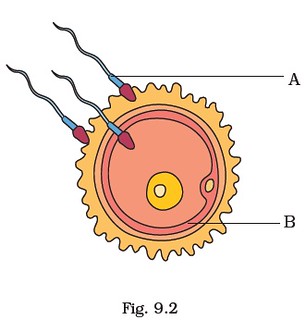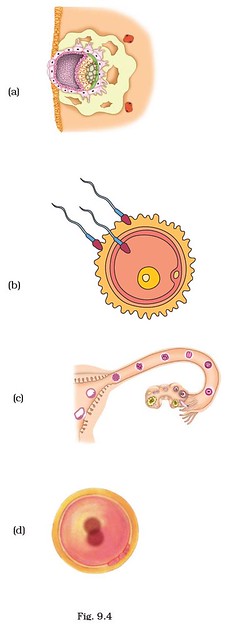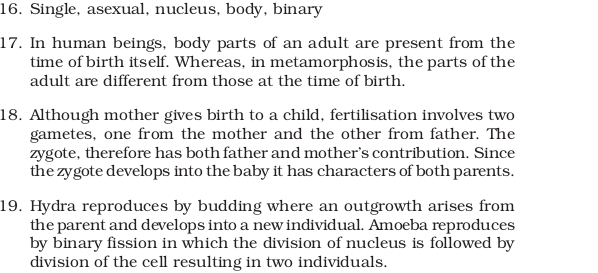Candidates can download NCERT Exemplar Class 8 Science Unit 9 from this page. The exemplar has been provided by the National Council of Educational Research & Training (NCERT) and the candidates can check it from below for free of cost. It contains objective, very short answer type, short answer type, and long answer type questions. Along with it, the answer for each question has also been provided. From the NCERT Exemplar Class 8 Science Unit 9, candidates can understand the level and type of questions that are asked in the exam.
NCERT Exemplar Class 8 Science Unit 9 Reproduction in Animals
NCERT Class 8 Science Unit 9 is for Reproduction in Animals. The type of questions that will be asked from NCERT Class 8 Science Unit 9 are displayed in the below provided NCERT Exemplar Class 8 Science Unit 9. With the help of it, candidates can prepare well for the examination.
Also Check: NCERT Solutions for Class 8 Science
Multiple Choice Questions
- Sets of reproductive terms are given below. Choose the set that has an incorrect combination.
(a) sperm, testis, sperm duct, penis
(b) menstruation, egg, oviduct, uterus
(c) sperm, oviduct, egg, uterus
(d) ovulation, egg, oviduct, uterus - In humans, the development of fertilised egg takes place in the
(a) ovary
(b) testis
(c) oviduct
(d) uterus - In the list of animals given below, hen is the odd one out.
human being, cow, dog, hen
The reason for this is
(a) it undergoes internal fertilisation.
(b) it is oviparous.
(c) it is viviparous.
(d) it undergoes external fertilisation. - Animals exhibiting external fertilisation produce a large number of gametes. Pick the appropriate reason from the following.
(a) The animals are small in size and want to produce more offsprings.
(b) Food is available in plenty in water.
(c) To ensure better chance of fertilisation.
(d) Water promotes production of large number of gametes. - Reproduction by budding takes place in
(a) hydra
(b) amoeba
(c) paramecium
(d) bacteria - Which of the following statements about reproduction in humans is correct?
(a) Fertilisation takes place externally.
(b) Fertilisation takes place in the testes.
(c) During fertilisation egg moves towards the sperm.
(d) Fertilisation takes place in the human female. - In human beings, after fertilisation, the structure which gets embedded in the wall of uterus is
(a) ovum
(b) embryo
(c) foetus
(d) zygote - Aquatic animals in which fertilisation occurs in water are said to be:
(a) viviparous without fertilisation.
(b) oviparous with external fertilisation.
(c) viviparous with internal fertilisation.
(d) oviparous with internal fertilisation. - After fertilisation, the resulting cell which gives rise to a new individual is the
(a) embryo
(b) ovum
(c) foetus
(d) zygote - In human beings, the correct sequence of events during reproduction is
(a) gamete formation, fertilisation, zygote, embryo
(b) embryo, zygote, fertilisation, gamete formation
(c) fertilisation, gamete formation, embryo, zygote
(d) gamete formation, fertilisation, embryo, zygote
Very Short Answer Type Questions
- Although 2 cells called gametes fuse, the product formed is a single cell called zygote. Justify.
- Stages in the life cycle of silkworm are given below. Write them in sequential order.
pupa, silkworm, egg, silkmoth - What is the importance of reproduction?
- In markets, eggs of birds are available but never eggs of dogs. Why?
- The eggs of frogs do not have shells for protection, yet they are safe in water. How?
Short Answer Type Questions
- Fill up the blanks with the terms given below:
body, asexual, binary, single, nucleus
Amoeba is a ___________ celled organism. It reproduces by ___________ reproduction. The process of reproduction begins by the division of its ___________ into two. This is followed by the division of its ___________ into two. This type of reproduction is called ___________ fission. - The term metamorphosis is not used while describing human development. Why?
- Mother gives birth to a baby but the baby has characters of both parents. How is this possible?
- How is reproduction in hydra different from that in amoeba?
- State whether the following statements are True or False. If false, correct the statement:
(a) External fertilisation can occur both in water and on land.
(b) The eggs of fish are covered by hard shells for protection.
(c) Human egg has a head, middle piece and tail.
(d) In adult human females, a single mature egg is released into an oviduct every month. - Why do only male gametes have a tail?

- Observe the figure given as Fig. 9.2 and answer the questions that follow.

(a) Label A and B.
(b) Identify the process.
(c) What happens during this process and what is formed?
Long Answer Type Questions
24. How can we say that fish exhibits external fertilisation?


25. After observing Fig. 9.3 answer the following.
a. Read the following statements and label them in the figure:
(i) The part which produces female gametes.|
(ii) The part where development of the baby takes place.
(iii) The part through which the developing embryo passes to reach the uterus.
b. Explain the future development of the embryo that would take place after it gets embedded in the uterus.
26. Hens and frogs are both oviparous exhibiting different types of fertilisation. Explain.
27. Observe the following figures.
(i) Identify the stages a to d in Fig. 9.4 during development of human baby.
(ii) Arrange the stages in correct sequence of development.
(iii) Explain the development that takes place in any one stage.
Click here to download the NCERT Exemplar Class 8 Science Unit 9 Reproduction in Animals
Answers to Multiple Choice Questions
Mutiple Choice Questions

Very Short Answer Questions

Short Answer Questions


Long Answer Questions


To get study material, exam alerts and news, join our Whatsapp Channel.

